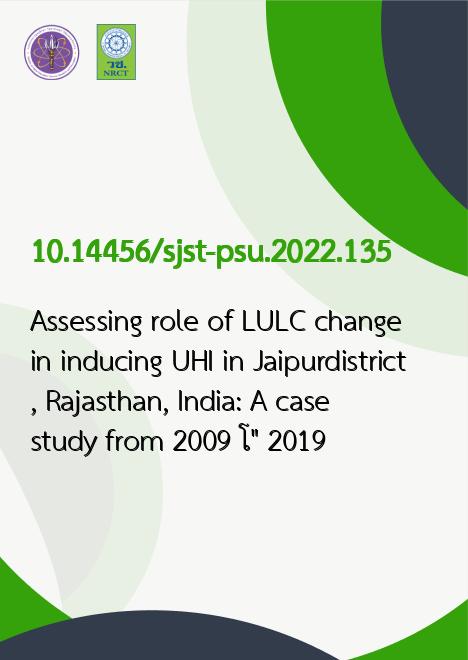
|
Assessing role of LULC change in inducing UHI in Jaipurdistrict, Rajasthan, India: A case study from 2009 โ" 2019 |
|---|---|
| รหัสดีโอไอ | |
| Creator | 1. Tanisha Ameriya 2. Udit Asopa 3. Charu Jhamaria |
| Title | Assessing role of LULC change in inducing UHI in Jaipurdistrict, Rajasthan, India: A case study from 2009 โ" 2019 |
| Publisher | Research and Development Office, Prince of Songkla University |
| Publication Year | 2565 |
| Journal Title | Songklanakarin Journal of Science an Technology (SJST) |
| Journal Vol. | 44 |
| Journal No. | 4 |
| Page no. | 1032-1039 |
| Keyword | GIS, land surface temperature (LST), land use/land cover, urban heat island |
| URL Website | https://rdo.psu.ac.th/sjst/index.php |
| ISSN | 0125-3395 |
| Abstract | The purpose of this study was to evaluate the decadal changes in the Land use/Land cover (LULC) pattern of the Jaipurdistrict that affect the occurrence of Urban Heat Island (UHI) from 2009 to 2019, by using remote sensing and GIS data. TheLandsat 7 and Landsat 8 datasets were classified using Supervised Maximum Likelihood classification method into classes:Urban, Vegetation, and Other. Further, using heatwave-based approach on land surface temperature (LST) maps, occurrence ofUHI was determined. The results indicate a 26.55% increase in the urban area cover with a subsequent rise of 50C in the meanLST from year 2009 to 2019. With the increase in LULC and LST over the study period, intensification in the occurrence ofUrban Heat Islands has been observed both in terms of their number and temperature. Interestingly, a 5.97% increase invegetation cover has also been observed during the decade, but the effect of increase in vegetation was negligible and could notprevent the UHI effect in the area. Furthermore, Jaipur master development plan 2025 indicates expansion in terms ofurbanisation and industrialization, so this study will be valuable for urban planners, policymakers, and relevant authorities inorder to achieve sustainable development. |
